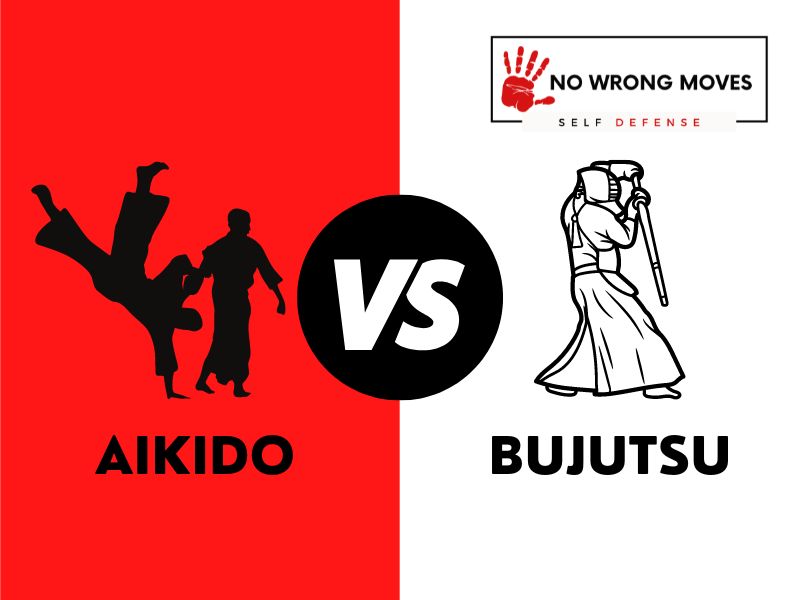
- What We Know About Aikido
- What We Know About Bujutsu
- Key Elements Of Aikido (Culture, Values, Practices etc.)
- Key Elements Of Bujutsu (Culture, Values, Practices etc.)
- Aikido Rankings & Levels
- Bujutsu Rankings & Levels
- Aikido Vs. Bujutsu Attire
- What A Typical Aikido Training Session Looks Like
- What A Typical Bujutsu Training Session Looks Like
- Movies With Aikido And Bujutsu
- Conclusion: Aikido Vs. Bujutsu
Many people in the martial arts community debate whether Aikido or Bujutsu is the better practice. While both offer unique benefits and principles, there are some key differences that set them apart.
The main difference between Aikido and Bujutsu is the approach to conflict.
- Aikido uses nonresistance and redirects the attack, while Bujutsu focuses on overpowering the opponent or enemy.
- In Bujutsu, winning at all costs is a priority, while Aikido strives more for harmonious resolution without causing harm to oneself or others.
- Aikido is a modernized form of traditional Japanese martial arts, while Bujutsu includes various forms of traditional Japanese combat techniques.
- Aikido also includes principles and philosophies derived from Eastern religions, while Bujutsu does not have this kind of spiritual aspect.
- Aikido training focuses on self-improvement and self-defense, while Bujutsu training is usually geared towards combat effectiveness in battle or warfare.
Overall, the two martial arts have their own distinct aims and approaches, and practitioners may choose to focus on one or both depending on their personal goals and interests. At the end of it all though, both can be valuable tools for self-defense and personal growth.
What We Know About Aikido
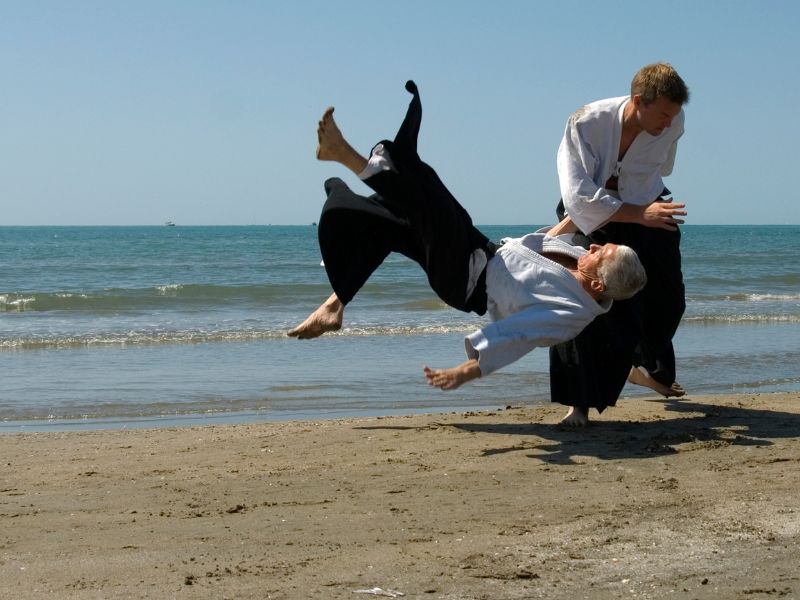
Aikido is a modern martial art that was created in the early 20th century by Morihei Ueshiba. It is based on the principles of budo, which follows the code of ethics of bushido.
Bushido is the code of ethics that samurai follow and teaches justice, courage, benevolence, politeness, honesty, honor, and loyalty.
Aikido is a combination of aikijujitsu, which is a martial art that uses both unarmed and armed fighting techniques, and iai-jutsu, which is a martial art that uses swordsmanship.
Aikido employs unarmed techniques, such as strikes, joint locks, and throws to subdue an opponent. It also makes use of weapons such as knives, swords, and sticks to defend against an attacker.
Aikido practitioners believe that one should only use the amount of force necessary to achieve their goals.
They also believe in using an opponent's momentum against them in order to control them rather than harm them.
Aikido is a challenging but rewarding martial art to study. It requires hefty discipline and dedication to master its techniques.
Thankfully though, the rewards are great for those who persevere, especially since Aikido can provide its practitioners with a sense of confidence and inner peace. It can also teach them how to better defend themselves and others in dangerous situations.
What We Know About Bujutsu
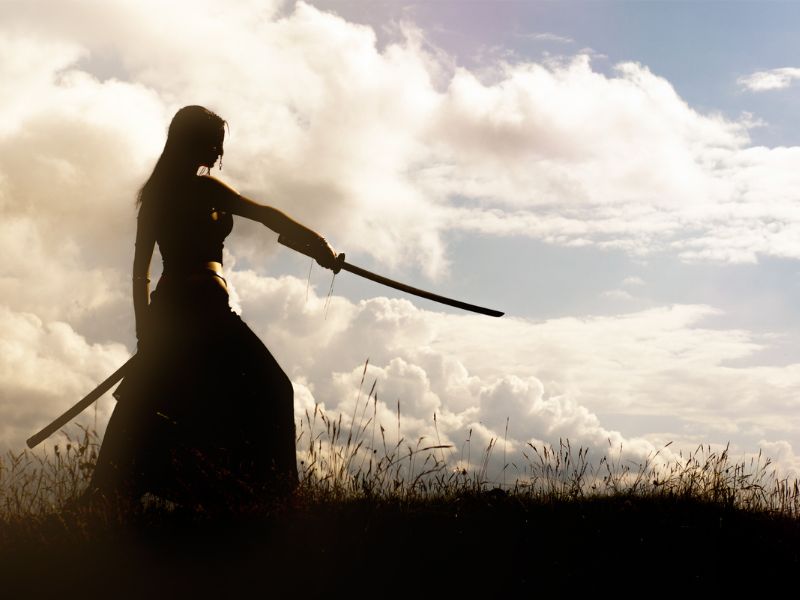
Bujutsu is an umbrella term that covers all of the traditional Japanese martial arts such as Kenjutsu, SoJutsu, Jojutsu and so on. Bujutsu was originally the sole preserve of the Samurai, though nowadays, Bujutsu techniques are practiced by many people around the world.
The term derives from the Japanese words for war (Bu) and technique or art (Jutsu), and Bujutsu can be translated to, almost literally, mean "martial arts."
Bujutsu includes a wide variety of different disciplines including swordsmanship, spear fighting, grappling, and stick fighting, as well as more modern disciplines, such as firearms training.
Bujutsu also covers a wide range of different weapons including swords, spears, knives, and even firearms.
Bujutsu techniques were developed over centuries of warfare in Japan, and they were refined through both practical experience on the battlefield as well as through formal training in one of the many Bujutsu schools that existed throughout Japan.
Many of the great Samurai families had their own Bujutsu schools, which were typically passed down from generation to generation, often becoming quite famous in their own right.
In modern times, Bujutsu has experienced something of a renaissance. Many people around the world have begun taking up the study of this ancient martial art.
While the direct practical applications of Bujutsu are obviously somewhat limited in today’s world, the discipline and self-control that it teaches are still absolutely highly valued by those who study it.
Of course, this is only a brief history and understanding of Aikido and Bujutsu, but if you want to go deeper into either art, be sure to check out the following posts:
Now, back to the comparison...
Let's look at the origins of the respective disciplines and then compare the key elements of their practices. You will be able to understand some of their similarities and differences a bit better afterward.
| Aikido | Bujutsu | |
| Origins | Japanese | Japanese |
Key Elements Of Aikido (Culture, Values, Practices etc.)
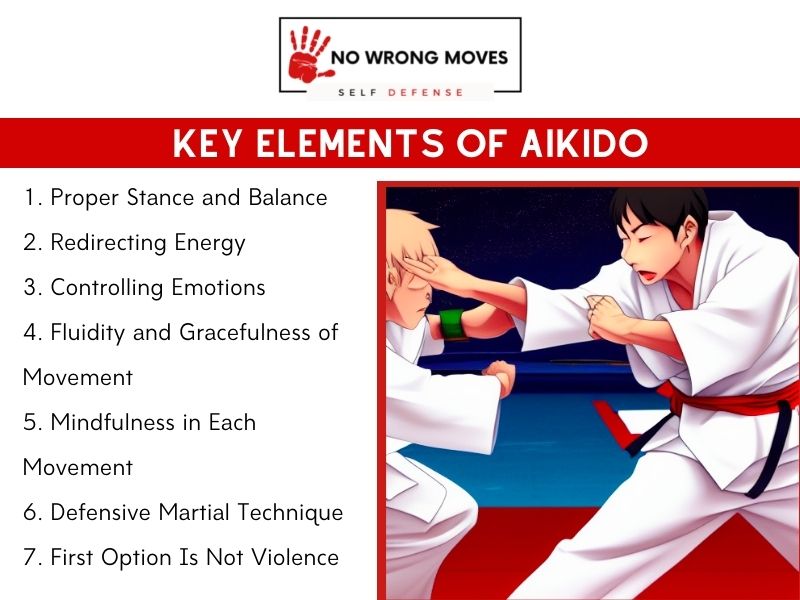
Aikido is a Japanese martial art that focuses on the proper stance and balance of the practitioner. Proper stance and balance are critical components of Aikido, as they provide the foundation for all other techniques.
A stable and balanced stance allows the practitioner to move fluidly and with control, making it easier to perform techniques effectively.
In Aikido, practitioners learn to redirect their opponent's energy rather than using force against them. Redirecting energy is one of the fundamental aspects of Aikido, and it's difficult to separate this idea from the sport itself.
Through properly redirecting an opponent's energy, Aikido practitioners can use their opponent's momentum against them, rather than relying on their own strength.
Apart from physical techniques, Aikido also emphasizes controlling one's emotions. Practitioners learn to remain calm and focused, even in stressful situations.
Aikido also places a strong emphasis on non-violent conflict resolution. The first option in any situation is to find a peaceful resolution, rather than resorting to violence.
Remember that in Aikido, the first option is not violence, and it reflects the overall philosophy of Aikido as a martial art focused on peace and harmony.
Key Elements Of Bujutsu (Culture, Values, Practices etc.)
Seishin (spirit):
This is the mental and spiritual aspect of training. It includes things like perseverance, courage, self-control and honor. All of these things are important not just in martial arts, but in life as well. Without them, we would never be able to accomplish anything worthwhile. Seishin is what sets us apart from the animals and allows us to achieve great things.
Seishin is something that must be developed through training and practice. It is not something that can be simply bought or possessed. One of the best ways to develop seishin is through kata (forms).
Kata (forms)
Kata are pre-arranged patterns of movements that help us to focus our minds and develop our techniques. They also help us to understand the principles behind the techniques we are using.
Kata training is not just about memorizing a bunch of moves; it is about understanding the principles behind the movements and applying them to real-world situations. It is also about developing our mental and spiritual discipline.
Kata training is an essential part of Bujutsu and should be practiced regularly.
Another thing I think is important to look at is the different rankings and levels in each art. if you are looking to take up either Aikido or Bujutsu, whether as a hobbyist or to compete, you need to understand the different levels of proficiency and what is required for testing and ranking.
Aikido Rankings & Levels
Aikido is a discipline that has many different levels, each represented by a different colored belt. The first level is white belt, which is for beginner students. Once you have mastered the basics of Aikido, you can move on to the blue belt, which is for intermediate students.
And finally, once you have mastered the art of Aikido, you can become a black belt, which is the highest level.
There are three degrees as a black belt holder: 1st dan, 2nd dan, and 3rd dan black belt. In order to achieve each of these degrees, you must pass a test that proves your mastery of Aikido.
There are also other ranks and colors that exist outside of the traditional ranking system. In some Western Aikido schools, there are more ranks added in between 1st dan and 2nd dan.
These ranks can be any combination of colors, and it allows for students to be promoted at a more gradual pace and helps to distinguish between students of different ranks.
Bujutsu Rankings & Levels
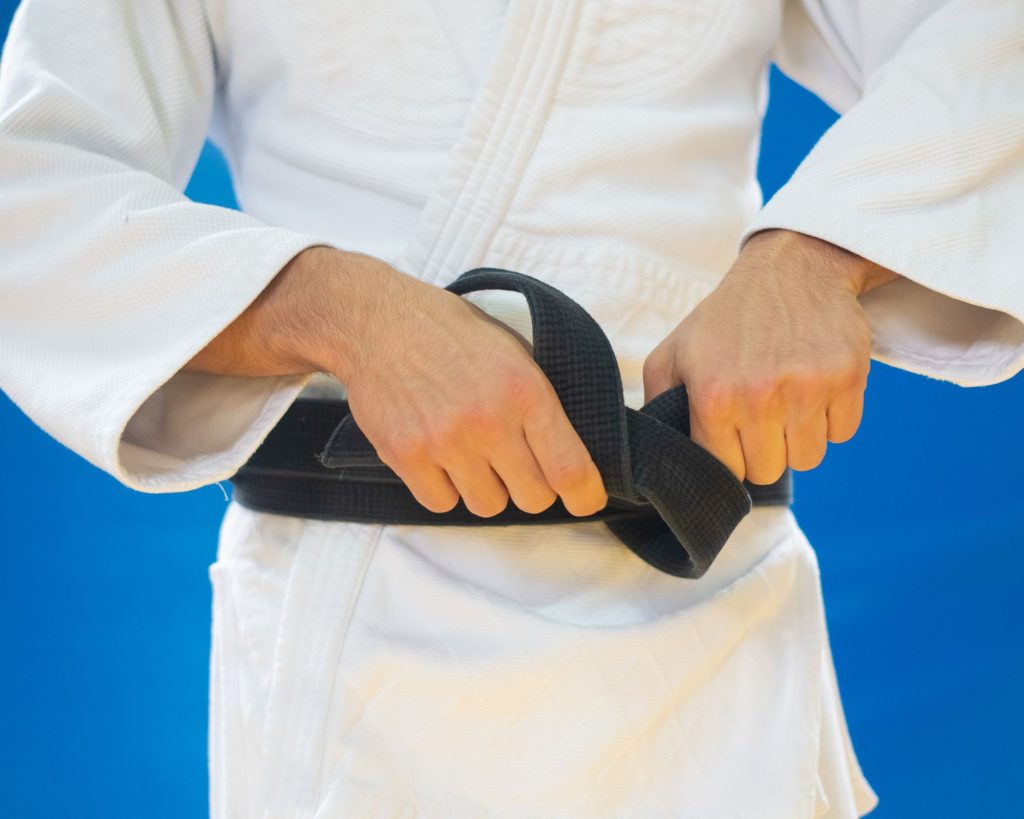
There are different levels and belts that practitioners can achieve in Bujutsu. The highest level is black belt, as you might've already suspected.
Below that, there are brown belts, followed by blue belts. The next lower rank is green belt, and the next lower rank after that is the orange belt.
Lower than that is the yellow belt, and finally, the lowest rank, designated for beginners, is the white belt. There are ten ranks for black belts all-in-all, increasing in their degrees--1st degree, 2nd degree, and so on
Each rank represents a higher level of skill and knowledge, and practitioners must dedicate themselves to continual learning in order to achieve the highest level of proficiency.
Aikido Vs. Bujutsu Attire
This section simply compares the clothing and uniforms that practitioners wear in combat.
Aikido Attire:
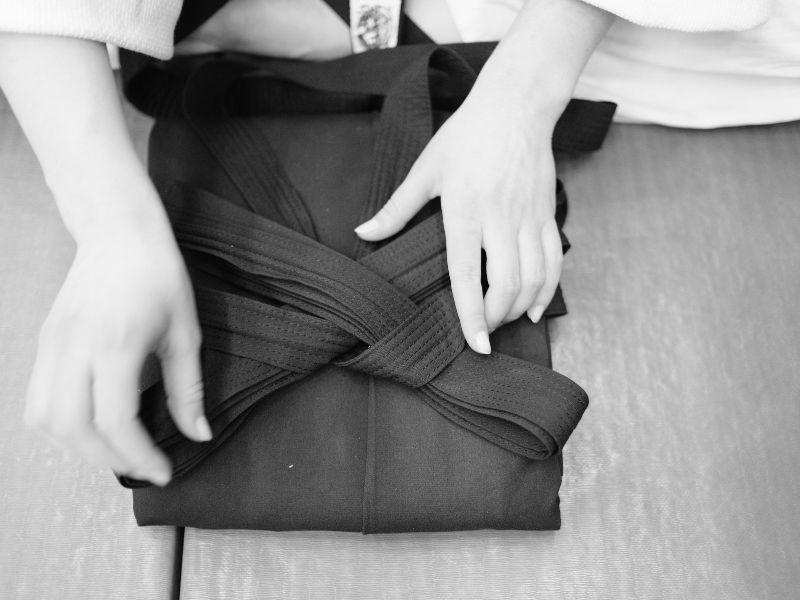
Most aikido practitioners wear a white dogi, or “uniform.” The dogi is a loose-fitting cotton kimono with a belt. In some schools, aikido students also wear hakama, which are pleated trousers that are tied at the waist and fall below the knee.
Male practitioners often don white tabi (socks), while female practitioners often wear white zori (wooden sandals). Some people also choose to practice without any clothes on in order to better feel their body and movements, but this isn't all too common.
Bujutsu Attire:
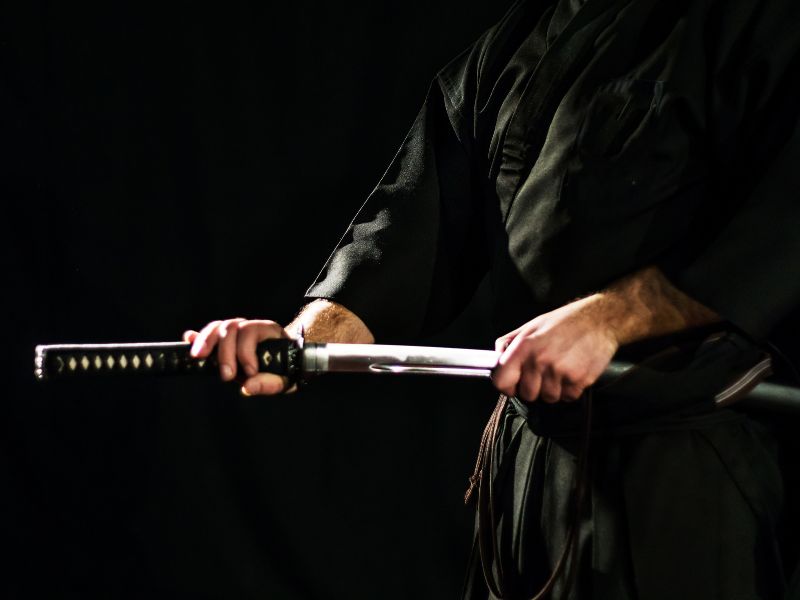
There is no standard uniform in Bujutsu. In general though, you can expect to see a black gi and hakama (a traditional garment worn by men in Japan), since these are the typical garments worn in most martial arts.
Some Bujutsu styles don't even encourage wearing a gi at all. Some schools choose to forgo the hakama altogether.
So it really depends on the school and the style of Bujutsu being practiced.
What A Typical Aikido Training Session Looks Like
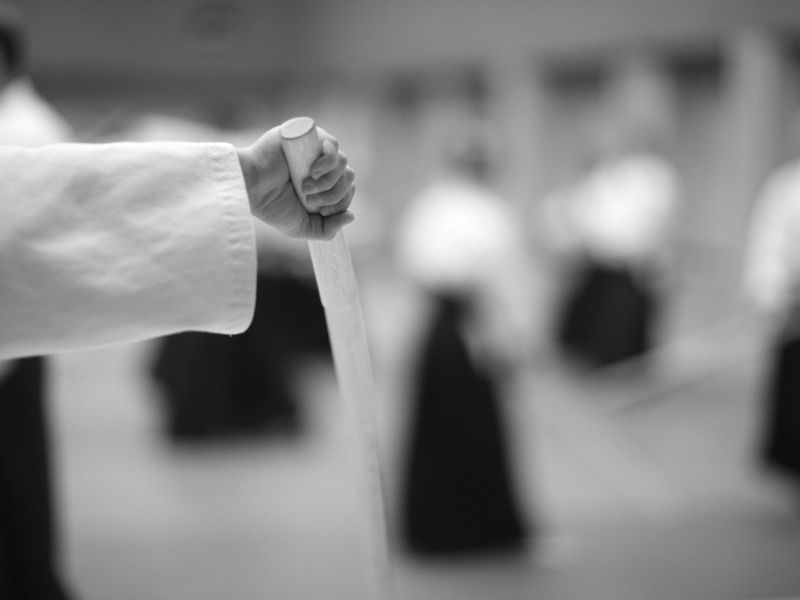
A typical Aikido practice session usually starts with a bow. This is a sign of respect for the dojo, the other students, and the instructor. The etiquette of aikido extends beyond just the bow, though. One must always be respectful, appreciative, and protective of all beings.
This attitude must be carried throughout the entire practice session.
Physical strain, whether during conditioning or in sparring against others, is part and parcel of Aikido. As such, practitioners need to maintain good manners and a positive attitude whenever they're in aikido class.
Aikido teaches you how to handle violence, but it still ultimately strives for peace, so never let your ego get in the way during your training.
Also remember that non-resistance is an essential element of proper aikido technique execution. Intercepting, deflecting, and redirecting an attack utilize the momentum and inertia of the attack.
Note that non-resistance does not mean being passively overpowered by the attack. But if you can avoid physical conflict, then you absolutely should.
It is also always important to maintain good posture and a relaxed body. Good posture includes maintaining your balance and keeping your center of gravity low. This helps you to be more aware of your surroundings and to respond more effectively to any situation.
Maintaining a relaxed body allows you to move more freely and makes it less likely that you will be thrown off balance by an attacker.
Similarly, be sure to focus on your breathing during aikido practice. This helps to calm and focus the mind, allowing for better decision making and execution of techniques.
Next, warm-up exercises are often done, including stretches and rolling or breakfalls (ukemi). These help to prepare the body for physical activity and prevent injury.
Following warm-ups, the instructor will lead the class through various aikido techniques and movements. These often involve practicing with a partner, called uke-nage (uke being the attacker, nage being the defender).
Practice with a spirit of cooperation, not necessarily competition. The goal is to mutually improve each other's technique and understanding of aikido principles, not to overpower or dominate the other person.
The practice session may also include weapons training, using a wooden sword (bokken) and wooden staff (jo). Weapons techniques often involve similar principles to those practiced with empty-handed techniques, but provide another layer of complexity and challenge.
What A Typical Bujutsu Training Session Looks Like
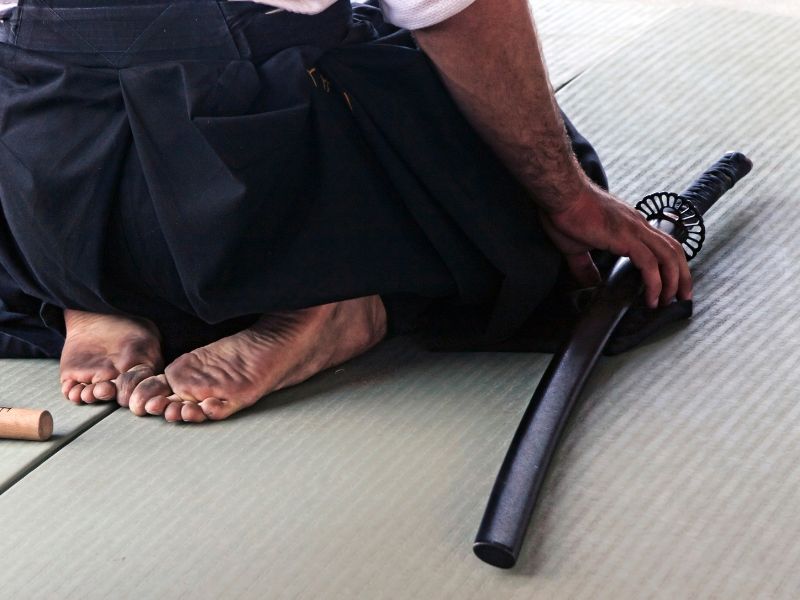
You can expect a typical session to follow this pattern:
- Warm-Ups
- Kihon
- Kata
- Randori
- Weapons Training
- Cool-Downs
Most bujutsu classes will start with a brief warm-up. This may involve some light stretching, calisthenics, or other exercises to get the blood flowing and the muscles loose. The purpose of the warm-up is to prevent injuries during the more strenuous training that will follow.
Kihon means "basic techniques" and refers to the fundamental movements of a particular martial art. In a bujutsu class, students will spend a significant amount of time practicing kihon.
This may involve striking techniques, throws, joint locks, or other basic moves. Kihon is important as it provides the foundation for all other techniques that will be learned.
Kata are pre-arranged sequences of moves that are performed alone or with a partner. Kata help students to learn proper form and technique, as well as to develop timing and rhythm. There are often many different kata in a single martial art, and students may spend years perfecting them.
Randori means "free sparring" and refers to any type of sparring that is not pre-arranged or choreographed. In randori, students face off against each other and attempt to score points with whatever techniques they have learned. Randori helps students to learn how to apply their techniques in a real-world setting and also fosters an environment of healthy competition.
Next is weapons training. Many bujutsu styles make use of weapons such as swords, knives, sticks, or staffs. In weapons training, students learn how to properly wield and use these weapons.
Students will often practice kata with weapons, as well as engage in randori with weaponized opponents. Weapons training can be both dangerous and exhilarating, and is often one of the most popular aspects of bujutsu for students.
And finally, at the end of most bujutsu classes, there will be a brief cool-down period. This may involve some light stretching or other exercises to help the muscles recover from the intense training that has taken place.
The cool-down is important in preventing injuries and helping the body to recover more quickly.
If the last few sections have been a bit full-on or a bit too technical, you will like this next section! Why? Because who doesn't love a good martial arts flick?
Both Aikido and Bujutsu have been featured in a number of films and TV shows, so if you want to learn more about them, then entertain yourself with the following 👊
Movies With Aikido And Bujutsu

These are some of the top movies and shows with Aikido in them:
- The Blind Swordsman: Zatoichi (2003)
- The Last Samurai (2003)
- Kill Bill: Vol. 1 (2003) and Kill Bill: Vol. 2 (2004)
- Street Fighter (1994)
- Ong-Bak: The Thai Warrior (2003)
- The Challenge (1982) TV series
Aikido can also be seen in popular shows such as:
- Daredevil (2015) TV series
- Arrow (2012) TV series
- Alias (2001-2006) TV series
- Chuck (2007-2012) TV series
- Xena: Warrior Princess (1995-2001) TV series
And some cool movies and anime with Bujutsu:
- Kenshin: The Legend Ends
- Princess Mononoke
- The Last Samurai
- Takeda Shingen
- Naruto
- Rurouni Kenshin
Conclusion: Aikido Vs. Bujutsu
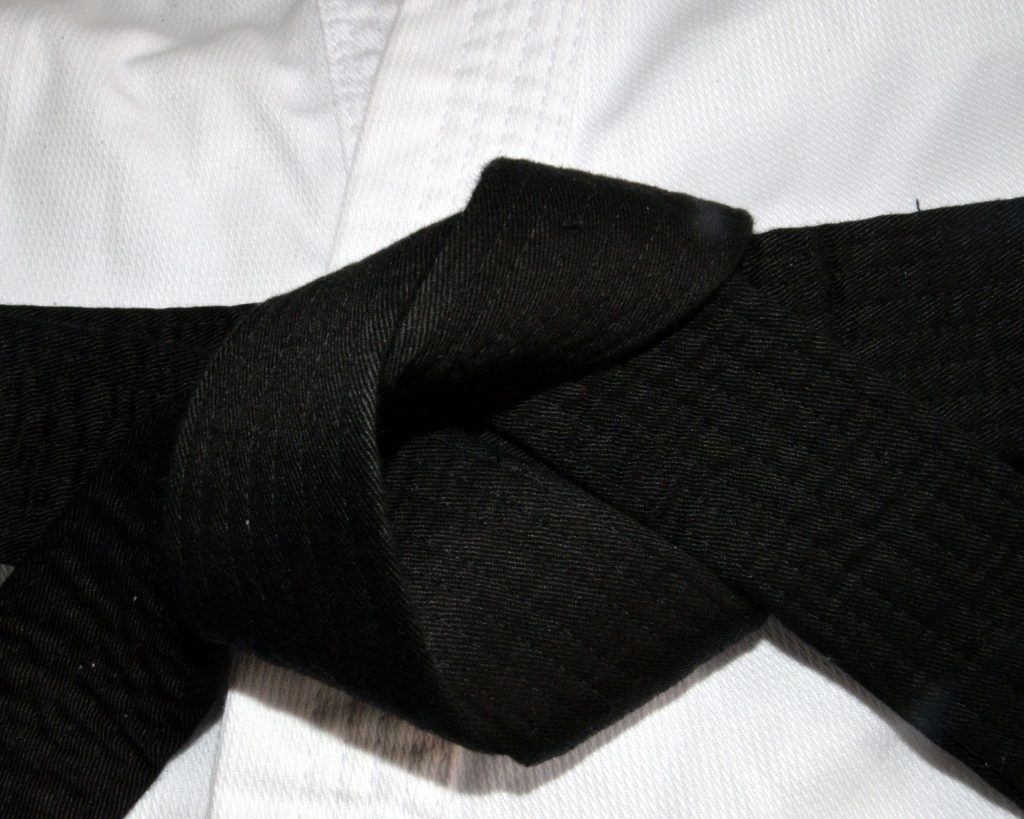
I hope you now have a deeper understanding of Aikido and Bujutsu. In all truth, it is not about which discipline is "better" as they each have their pros and cons.
If you do plan on starting classes for either, please check out my other related posts, as I have tried my best to answer all the FAQs related to the art.
Feel free to share this post and any graphics you like, and of course, if you have any questions or thoughts, drop them below or shoot me an email, and I will be happy to assist 🙂
Learn more about Bujutsu here!
[author-box-jpx-fitness]
